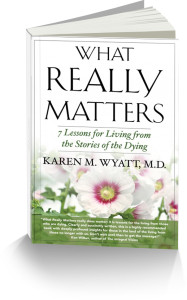
Since my father’s suicide death 28 years ago I have been on a long journey of grief with many twists and turns, detours and dead-ends, which I have chronicled in a series on my End-of-Life University podcast. After the devastation of his death I wondered if I would ever be able to feel joy again in my life. But I am here to say now that it is possible to feel joyful, alive and grateful after enduring such trauma, even though the grief will never disappear.
Lately I’ve been reading a lot of blog posts that warn readers “What Not to Say” to a person who is grieving. The authors advise against such platitudes as “Grief is a process,” “You’re on a journey,” “It will get better one day,” and “You’ll learn something from this.” I’ll admit that in the first few years after my father’s death I couldn’t even bear to hear the word “suicide” and I too ran away from well-meaning friends who tried to console me.
But so many years later … after a great deal of work and struggle … I have to say that for me, grief has been a process that has taken me on a journey and things have gotten a great deal better as I have learned many lessons about life and death. For me there has been “a light at the end of the tunnel.” And while I would never push my current perspective onto someone else who is grieving, I can wish for that person to find solace and comfort as they deal with the pain in their own unique way.
I do believe that there is value in sharing my process and what I have learned through years of grief and guilt. So these steps of mine are not meant to preach to others who are grieving, but simply to share my experience of what it has taken for me to find joy once again.
Patience
I had to learn right away that my grief would not be resolved quickly (or ever) and that it was important for me to allow plenty of time. As much as I wanted to be done with the pain and go back to living my old life, I had to slow down and wait patiently for tiny glimmers of hope to appear. Each time I tried to take shortcuts through my own healing I ended up prolonging it and having to start over again.
Grief has its own timing and cannot be rushed.
Stillness
While my mind was busy racing with “What ifs” and “Should haves” about my father’s death and my emotions were erupting on a regular basis, I wondered why I could never feel joyful. But over time I gradually recognized that joy arises from stillness. I learned to create quiet spaces in my life and in my thoughts. Eventually I spent more and more time being still and allowing glimpses of happiness to appear within me.
Create still spaces inside that joy can fill.
Facing Emotions
Many of my emotions during the years of heavy grieving were chaotic, frightening and destructive so I constantly tried to hide or ignore them. But I slowly learned that healing would come only after facing up to those feelings and going through them. I had to embrace all of my emotions as a natural part of who I am in order to soothe them and eventually lessen their intensity.
Learn to face and accept all of the turbulent emotions of grief.
Allowing Change
For several years I would say to myself every morning “Some day I will wake up and be like I used to be before …” I kept expecting the pain to just disappear so that I could go back to who I was in the past. But grief is an experience that is meant to change us. Grief holds the keys to who we are right now and who we are going to become. There is no going backwards; focusing on the past just prolongs the pain.
Grief transforms you into who you really are.
Letting go of expectations
Ultimately in my long process of healing deep grief I had to adjust my expectations. I had to recognize that life would never be the same again, I would never be the same person again, and I couldn’t expect anything to turn out the way I wanted it to be. There was a “new normal” for my life and that included finding quiet joy in small moments each day rather than over-the-top jubilation. I would learn to connect together moment after moment of simple happiness until my life became filled with what I though of as “Buddha joy,” with the slight smile and the calm presence that Buddha statues exhibit.
Real joy is simple and serene.
So after 28 years of work on my own grief, this is what I have learned. But I am still growing and changing every day so I don’t doubt that there are many more lessons ahead for me. Now I wake up every morning grateful to be alive, looking forward to what the day might hold, and in awe of the mystery of life. Grief has led me here and I honestly would not go back.
This place … this moment … this stillness … is perfect for me right now and I am in need of nothing more. For everyone else struggling with grief at this time … I see you, I honor your experience, and I hold you in my heart with love.
About the Author:
 Dr. Karen Wyatt is a hospice and family physician who writes extensively on spirituality and medicine, especially at the end-of-life. She is the author of the award-winning book “What Really Matters: 7 Lessons for Living from the Stories of the Dying.” Connect with her at karenwyattmd.com, on Facebook at fb.com/WhatReallyMattersWithKarenWyatt and on Twitter @spiritualmd
Dr. Karen Wyatt is a hospice and family physician who writes extensively on spirituality and medicine, especially at the end-of-life. She is the author of the award-winning book “What Really Matters: 7 Lessons for Living from the Stories of the Dying.” Connect with her at karenwyattmd.com, on Facebook at fb.com/WhatReallyMattersWithKarenWyatt and on Twitter @spiritualmd

